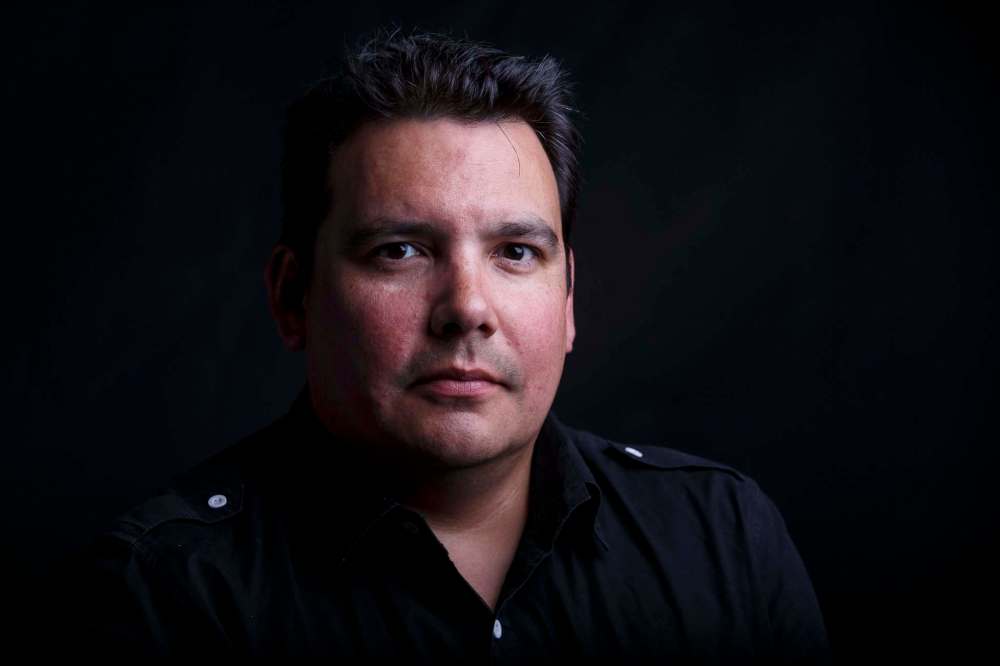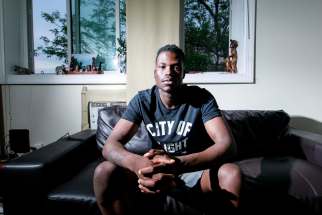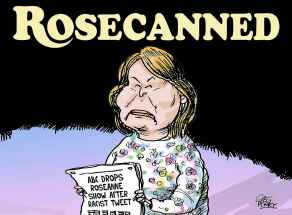Sharing stories from here, our home Meet Niigaan Sinclair, the newest Free Press columnist
Read this article for free:
or
Already have an account? Log in here »
To continue reading, please subscribe:
Monthly Digital Subscription
$0 for the first 4 weeks*
- Enjoy unlimited reading on winnipegfreepress.com
- Read the E-Edition, our digital replica newspaper
- Access News Break, our award-winning app
- Play interactive puzzles
*No charge for 4 weeks then price increases to the regular rate of $19.00 plus GST every four weeks. Offer available to new and qualified returning subscribers only. Cancel any time.
Monthly Digital Subscription
$4.75/week*
- Enjoy unlimited reading on winnipegfreepress.com
- Read the E-Edition, our digital replica newspaper
- Access News Break, our award-winning app
- Play interactive puzzles
*Billed as $19 plus GST every four weeks. Cancel any time.
To continue reading, please subscribe:
Add Free Press access to your Brandon Sun subscription for only an additional
$1 for the first 4 weeks*
*Your next subscription payment will increase by $1.00 and you will be charged $16.99 plus GST for four weeks. After four weeks, your payment will increase to $23.99 plus GST every four weeks.
Read unlimited articles for free today:
or
Already have an account? Log in here »
Hey there, time traveller!
This article was published 01/06/2018 (2751 days ago), so information in it may no longer be current.
My family has always been here.
Anishinaabe (Ojibway) from the south. Mushkego (Swampy Cree) from the north.
Not just these nations, mind you. We adopted many along our path. Zhaaganashag (British). Wemitigoozhiwag (French). Others.
Sinclair, after all, is maybe the most Scottish name there is.
My family is a product of trade on the Red River, as settlers and Indigenous people came together to forge treaty and family here.
Making the Manitoba we see today.

My great-grandparents, Catherine Simard and Henry Sinclair, settled on lands known as the St. Peter’s Indian Reserve (also known as Little Peguis), a community founded by Chief Peguis a century earlier near Selkirk.
In 1907, Canada forcibly relocated our people to what’s now Peguis First Nation in the Interlake. Most of our relatives left. Some, like my family, stayed. Over the following decades police and farmers called us squatters.
I prefer resisters.
In the 1960s, my family moved into the town (now city) of Selkirk. Many are still there.
This is where I come in.
I spent almost all my life in Selkirk, growing up (ironically) on Manitoba Avenue. From the daycare in the friendship centre to playing hockey in Gaynor Foods parking lot, I was woven from the threads of a small Prairie town.
From the editor: Wisdom, wit and an Indigenous perspective
For the past 146 years, the Winnipeg Free Press has been telling the stories of this city and province on the pages of what is the oldest newspaper in Western Canada.
But as proud as we are of that legacy, the Free Press is still very much the new kid on the block when it comes to telling stories, providing perspective and sharing insights into what we all now know as Manitoba.
The historical record will show those first here on the Prairies were the original custodians of the stories and lessons of the land — long before a press in a rented shack on Main Street cranked out the first edition of the Free Press.
For the past 146 years, the Winnipeg Free Press has been telling the stories of this city and province on the pages of what is the oldest newspaper in Western Canada.
But as proud as we are of that legacy, the Free Press is still very much the new kid on the block when it comes to telling stories, providing perspective and sharing insights into what we all now know as Manitoba.
The historical record will show those first here on the Prairies were the original custodians of the stories and lessons of the land — long before a press in a rented shack on Main Street cranked out the first edition of the Free Press.
Unfortunately, that same historical record will show that once newsrooms opened across the country, there was no room for the ancestors of those first storytellers. And even 150 years into Confederation, for a nation that prides itself on diversity, First Nations’ perspectives often come last in far too many newsrooms.
Today, however, the Free Press will do what we believe no other major Canadian daily has done before — hand the marquee role of city columnist to an Indigenous writer.
Niigaan Sinclair is an Anishinaabe whose life began on the land that was once St. Peter’s Reserve. Alas, his birthplace was also the subject of an illegal surrender and transfer to present-day Peguis First Nation, in what could easily be argued was an example of ethnic cleansing — not that the Free Press reported it as such more than a century ago.
As a boy growing up in Selkirk, Sinclair read the Free Press and dreamed one day of writing for the newspaper.
But his career path would take a different course, leading to a PhD from the University of British Columbia and a role as assistant professor in the University of Manitoba’s native studies department. Along the way, Sinclair became an author, a much sought-after speaker throughout North America, and a frequent contributor to newspapers from the Free Press to the Globe & Mail to The Guardian.
Sinclair’s dream becomes a reality now with his first column as a member of our newsroom.
Columnists are a key ingredient of any good newspaper. They bring personality and a point of view. They enable us to see things we might not otherwise see with compelling commentary. They deliver clarity by way of penetrating prose. They become destinations for readers because of the value of their voice.
Sinclair will be all of that and more. And at this point in the history of our city, province and country, it is high time this newspaper, published on Treaty 1 territory since 1872, shares some of the power of our print and pixels with someone who can help all of us reconcile certain truths about Canadian society.
Sinclair’s columns won’t always go down easy with all of our readers; truth can sometimes spark indignation. But strong writing is often provocative.
For those keen to be challenged in order to learn more, Sinclair will be a welcome addition to these pages. For those less keen, fasten your seatbelts.
In either case, the wit and wisdom Sinclair brings to these pages will provide a perspective I wish had always been part of our newspaper’s tradition, and an understanding that holds the promise of better days for all of us.
— Paul Samyn is the Free Press Editor
My family experienced first-hand the brutality of Canada’s 150 years of policies and practices surrounding Indigenous peoples. We know land loss, residential school, alcoholism and abuse. We definitely know racism. My family is not defined by trauma, but we are impacted by it, even today.
Still, I watched the Jets and loved Pokey Reddick. My best friend was (and is) a Ukrainian guy from Lockport. I went to powwows in Brandon and ceremonies in Roseau. I’ve been all over Manitoba.
While a kid I delivered the Winnipeg Free Press door to door. I remember seeing photos of Elijah Harper saying “no” to Meech Lake. I read about the resistance at Oka. I still have clippings of the Aboriginal Justice Inquiry.
I was shaped by this place. The good. The bad. The ugly. The great.
Still, while growing up I was surrounded by incredible, strong Indigenous relatives who cared for, supported and protected me. Most Manitobans likely know my father, Murray (yes, the senator), but as important were my Auntie Diane, my Uncle Jim, and my cousins and sisters. Joining them were brave non-Indigenous peoples — like my mother Jeanette — who worked to ensure that I would never forget where I come from.
My most important lesson was from my Auntie Rose, who told me, while demonstrating how to knead bannock, to always be proud of who I am.
I’m still working on it, especially the kneading.
After high school, I travelled to South Africa as an exchange student to witness the fall of apartheid, their first all-race elections, and the election of Nelson Mandela as that nation’s first African president. I watched how racism could be overturned with fierce resistance and almost unbelievable commitments to peace and non-violence. I saw how a nation could be re-made.
Returning in 1994, I became a teacher. My first job was teaching English and Drama at École Kelvin High School as one of the first Indigenous teachers in south Winnipeg. I found myself doing three jobs, educating not just students but staff and administration on everything Indigenous. None of this was in my job description.
I’ll never forget the day I found out I would be helping direct Fiddler on the Roof. I became nervous. I knew nothing about Jewish culture, language, or history. I didn’t even know why the fiddler was on the roof.
Four months later, I was adjusting yarmulkes and coaching students in the kiddushin (wedding) scene. I was not an expert by any means, but I learned enough to give dignity to very complex traditions.
This is the argument I now make for teachers working in Indigenous education.
A few years later, I decided to go to graduate school and become a writer but became a professor by default. With pit stops in Oklahoma, British Columbia, Ontario and the arrival of a beautiful daughter, I returned home in 2008 and was hired in 2012 by the University of Manitoba’s native studies department. I’ve been teaching and writing since.
This past spring, the paper I once carried had a job opening.
So here we are.
I’m a product of this place. Like many, my family has never not been in Manitowapow, the place where life comes from the water, or Manito Api, the place where Creator sits. Centuries flow through our lives and memories from our time here.
And we’re still here. Living. Thriving. Telling stories.
Bozhoo, tansi, niminwendam omaa ayaan. It’s nice to meet you.
I look forward to sharing with you more stories of this place, our home.
Here.
niigaan.sinclair@freepress.mb.ca
@Niigaanwewidam

Niigaan Sinclair is Anishinaabe and is a columnist at the Winnipeg Free Press.
Our newsroom depends on a growing audience of readers to power our journalism. If you are not a paid reader, please consider becoming a subscriber.
Our newsroom depends on its audience of readers to power our journalism. Thank you for your support.







